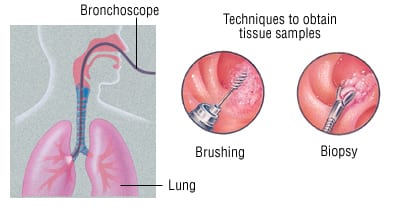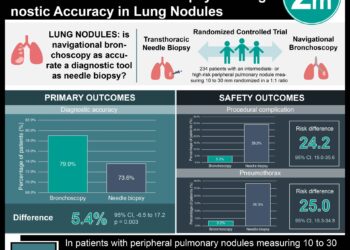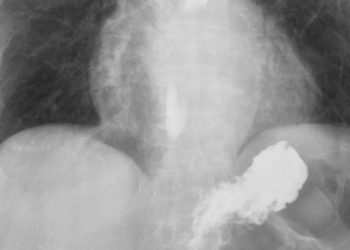Patient Basics: Bronchoscopy
Originally published by Harvard Health.
What Is It?
Bronchoscopy is an examination of the larger airways (trachea and bronchi) using an instrument called a bronchoscope. A bronchoscope is a type of endoscope — a flexible instrument that sees inside the body using fiberoptic technology (very fine filaments that can bend and carry light). In bronchoscopy, the doctor can look directly inside the larger breathing passages for signs of tumors and can take samples of lung fluids or tissue if necessary.
During bronchoscopy, a flexible bronchoscope is inserted through the mouth or nose, then slowly passed down into the trachea and bronchi. To limit discomfort, the mouth or nose is numbed with a local anesthetic beforehand and a light sedative may also be injected into the veins. The bronchoscopy procedure itself usually takes about 30 to 60 minutes, not counting preparation time.
A rigid bronchoscope sometimes is used instead of a flexible fiber-optic instrument. The rigid instrument doesn’t bend, doesn’t see as far down into the lungs as the flexible one, and may have a greater risk of causing injury to nearby structures. Because it can cause more discomfort than the flexible bronchoscope, it requires stronger anesthesia and is usually done in an operating room of a hospital. However, it is useful in certain situations, such as for taking large samples of tissue, treating certain cancers and removing foreign bodies.
What It’s Used For
Bronchoscopy is used so a doctor can look at the trachea and bronchi directly. This may be necessary to diagnose lung tumors, infections such as tuberculosis or inflammatory conditions of the lungs. It is also used to check the airways for signs of bleeding, and to stop bleeding or remove objects. If your doctor sees a suspicious area during bronchoscopy, an attachment can be placed on the end of the bronchoscope to take a small sample of tissue to be examined in a laboratory.
Preparation
Because you will probably be a little groggy after the bronchoscopy procedure, you will not be able to drive. Be sure to make arrangements for a friend or family member to help you get home.
When your doctor schedules your bronchoscopy, he or she will want to know if you have any bleeding problems or any allergies to medications or anesthetics. Also tell the doctor about any medicine that you are taking or have stopped taking recently. You will be told not to take certain prescription and nonprescription medications before the procedure. In particular, blood thinners and nonsteroidal anti-inflammatory drugs (NSAIDs) can cause excessive bleeding during the procedure. If you have any loose teeth, point them out before bronchoscopy begins. Also, if you are pregnant or there is any chance that you might be pregnant, tell the doctor.
Your doctor will ask you not to eat or drink anything for about 6 to 12 hours before your bronchoscopy. If you smoke, your doctor probably will ask you to stop for about 24 hours before the procedure. You also will need to remove any dentures, eyeglasses, contact lenses or jewelry.
How It’s Done
Your vital signs (temperature, pulse, blood pressure and respiratory rate) will be measured and recorded. A device called a pulse oximeter may be attached to your ear, finger or toe to monitor the oxygen level in your blood. A sterile tube will be placed in a vein in your arm so that you can receive medication to ease discomfort.
You will lie down on an examining table with your head on a pillow, and you will be given medication to numb your nose or throat. The doctor will pass the flexible bronchoscope gently through your nose or mouth, then into your windpipe and lower airways. Although you will not be able to talk, you will be able to breathe, and the doctor’s assistant will give you extra oxygen as necessary. Depending on the purpose of your bronchoscopy, the doctor may use special bronchoscope attachments to take samples of fluid or tissue from inside your lungs.
Follow-Up
After bronchoscopy, you will be watched until you feel well enough to leave. Because you will not be able to drive, a friend or family member should be there to help you get home safely. Your doctor will tell you when you can resume eating and drinking and when you can return to your normal daily activities.
Your throat may feel sore or dry after the procedure; ask your doctor about soothing lozenges or gargles to use at home.
Risks
During bronchoscopy, there is a remote risk of an allergic reaction to the anesthetics used. There is also a risk that the bronchoscope could injure your nose, parts of your mouth or throat, teeth or breathing passages, or puncture the lung. Rare medical complications include abnormal heart rhythms, heart attack and low oxygen levels in your blood.
When To Call a Professional
Call the doctor immediately if you begin to cough up blood after bronchoscopy, or if you have shortness of breath, chest pain, wheezing or difficulty breathing. Also call your doctor if you develop a fever, with or without any breathing problems.
Additional Info
American Lung Association
61 Broadway, 6th Floor
New York, NY 10006
Phone: 212-315-8700
Toll-Free: 1-800-548-8252
http://www.lungusa.org/
American Cancer Society (ACS)
1599 Clifton Road, NE
Atlanta, GA 30329-4251
Toll-Free: 1-800-227-2345
http://www.cancer.org/
National Cancer Institute (NCI)
U.S. National Institutes of Health
Public Inquiries Office
Building 31, Room 10A0
331 Center Drive, MSC 8322
Bethesda, MD 20892-2580
Phone: 301-435-3848
Toll-Free: 1-800-422-6237
TTY: 1-800-332-8615
http://www.nci.nih.gov/
National Heart, Lung, and Blood Institute (NHLBI)
P.O. Box 30105
Bethesda, MD 20824-0105
Phone: 301-592-8573
TTY: 240-629-3255
Fax: 301-592-8563
http://www.nhlbi.nih.gov/








